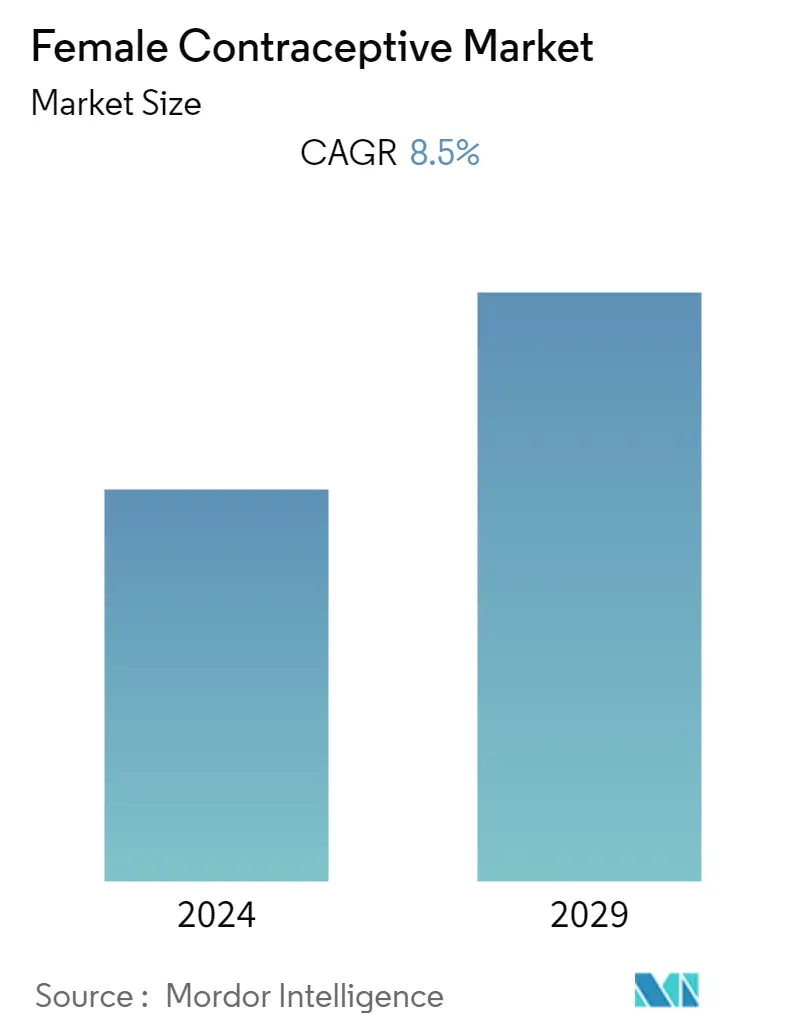Market Size of Female Contraceptive Industry

| Study Period | 2019 - 2029 |
| Base Year For Estimation | 2023 |
| CAGR | 8.50 % |
| Fastest Growing Market | Asia Pacific |
| Largest Market | North America |
| Market Concentration | Low |
Major Players
*Disclaimer: Major Players sorted in no particular order |
Female Contraceptive Market Analysis
The female contraceptive market is expected to register a CAGR of 8.5% during the forecast period.
The COVID-19 pandemic has impacted the growth of the studied market in its initial phase owing to the disruption in the supply chains of contraceptives. For instance, according to an article published in March 2022 in Contraception and Reproductive Medicine, it was observed that the use of long-acting contraceptives decreased with implants by 76%, intrauterine systems by 79%, and intrauterine devices by 76% during the initial phase of a pandemic. Also, according to United Nations Population Fund's data published in March 2021, the COVID-19 epidemic disrupted family planning services for an estimated 12 million women, resulting in 1.4 million unplanned pregnancies. However, the market has gradually increased in the last few years due to rising awareness regarding contraception use and access to the same in the later period of the pandemic.
Certain factors that are propelling the market growth are increasing incidences of sexually transmitted diseases (STDs), increasing rates of unintended pregnancies, and rising government initiatives.
The number of unwanted pregnancies is increasing globally, and it is a matter of serious concern all around the world. For instance, according to the United Nations Population Fund, in March 2022, unintended pregnancies accounted for about half of all pregnancies worldwide, with 121 million occurring each year. As per the same source, over 60% of unplanned pregnancies end in abortion, with an estimated 45% of all abortions being unsafe, resulting in 5%-13% of all maternal fatalities, putting the world's capacity to meet the "Sustainable Development Goals" at risk. Additionally, according to the article published in the BMC Pregnancy and Childbirth 2021 by Nebamallika Dahingia, unintended pregnancies affect approximately 85 million women worldwide, with India accounting for more than 1 in every 7 of these cases. In addition, as per the same source, Uttar Pradesh, India's most populous state (population of approximately 200 million), has twice the unwanted fertility rate as compared to the rest of the country. Thus, the rising number of unintended pregnancies is expected to boost the female contraceptive market over the forecast period.
In addition, the rising prevalence of sexually transmitted diseases among the population is expected to increase market growth. For instance, as per the data published by the WHO in November 2021, more than 1.0 million sexually transmitted infections are acquired every day globally and most of them are asymptomatic. It also reported that every year there are an estimated 374.0 million new infections with 1 out of 4 sexually transmitted infections including gonorrhea, chlamydia, trichomoniasis, and syphilis. Thus, the high burden of sexually transmitted diseases is expected to increase the demand for contraception to avoid getting diseases, thereby propelling the market growth.
Furthermore, the strategic initiatives by market players also contribute to market growth. For instance, in December 2021, Gedeon Richter Unite Kingdom Ltd became a marketing authorization holder (MAH) for Evra, a once-weekly transdermal contraceptive patch for women of fertile age in the United Kingdom. Such authorizations are expected to propel the availability of contraceptive devices in the country during the forecast period.
Therefore, owing to the aforesaid factors such as the high burden of STDs and rising launches, the studied market is expected to grow during the forecast period. However, the high cost of devices and treatment and side effects associated with the use of contraceptive drugs and devices are likely to restrain the market growth over the forecast period.
Female Contraceptive Industry Segmentation
As per the scope of the report, contraception is defined as the intentional prevention of conception through the use of various devices, sexual practices, chemicals, drugs, or surgical procedures to prevent a woman from becoming pregnant. These devices and drugs function by acting as a physical barrier between the sperm and ovum or by changing the mechanism of ovulation. The Female Contraceptive Market is segmented by Contraceptive Drugs (Oral Contraceptives, Topical Contraceptives, Contraceptive Injections, Spermicides), Devices (Female Condoms, Diaphragms and Caps, Vaginal Rings, Contraceptive Sponges, Sub-dermal Contraceptive Implants, Intra-Uterine Contraceptive Devices (IUCDs) and Other Devices), and Geography (North America, Europe, Asia-Pacific, Middle East, and Africa, and South America). The market report also covers the estimated market sizes and trends for 17 different countries across major regions, globally. The report offers the value (in USD million) for the above segments.
| By Contraceptive Drugs | ||||
| ||||
| Contraceptive Injections | ||||
| Topical Contraceptives | ||||
| Spermicides |
| By Device | ||||
| Female Condoms | ||||
| Diaphragms and Caps | ||||
| Vaginal Rings | ||||
| Contraceptive Sponges | ||||
| Sub-dermal Contraceptive Implants | ||||
| ||||
| Other Devices |
| Geography | ||||||||
| ||||||||
| ||||||||
| ||||||||
| ||||||||
|
Female Contraceptive Market Size Summary
The female contraceptive market is poised for significant growth, driven by increasing awareness and access to contraceptive methods post-pandemic. The market is experiencing a resurgence after initial disruptions caused by COVID-19, which had a notable impact on supply chains and family planning services. Factors such as the rising incidence of sexually transmitted diseases and unintended pregnancies are propelling market expansion. Government initiatives and strategic actions by key players, including product launches and regulatory approvals, are further enhancing market dynamics. The sub-dermal contraceptive implants segment is expected to witness substantial growth due to its high clinical effectiveness and adoption rate.
North America is anticipated to hold a significant share of the market, supported by advanced healthcare infrastructure and government subsidies for contraceptive access. The region's market growth is bolstered by strategic initiatives from organizations like the Bill & Melinda Gates Foundation, which aims to improve contraceptive technologies and support family planning programs. The competitive landscape is characterized by fragmentation, with major players like Bayer AG, Pfizer Inc, and Merck & Co, Inc. focusing on cost-effective solutions to capture market share. The ongoing launches and approvals of new contraceptive products are expected to further drive market growth, offering companies opportunities to expand their presence in this vital sector.
Female Contraceptive Market Size - Table of Contents
-
1. MARKET DYNAMICS
-
1.1 Market Overview
-
1.2 Market Drivers
-
1.2.1 Increasing Incidence of the Sexually Transmitted Diseases (STDs)
-
1.2.2 Increasing Rate of Unintended Pregnancies
-
1.2.3 Rise in Government Initiatives
-
-
1.3 Market Restraints
-
1.3.1 High Cost of Devices and Treatment
-
1.3.2 Side Effects Associated with the Use of Contraceptive Drugs and Devices
-
-
1.4 Porter's Five Force Analysis
-
1.4.1 Threat of New Entrants
-
1.4.2 Bargaining Power of Buyers/Consumers
-
1.4.3 Bargaining Power of Suppliers
-
1.4.4 Threat of Substitute Products
-
1.4.5 Intensity of Competitive Rivalry
-
-
-
2. MARKET SEGMENTATION (Market Size by Value in USD Million)
-
2.1 By Contraceptive Drugs
-
2.1.1 Oral Contraceptives
-
2.1.1.1 Combined Oral Contraceptive Pill
-
2.1.1.2 Other Oral Contraceptive Drugs
-
-
2.1.2 Contraceptive Injections
-
2.1.3 Topical Contraceptives
-
2.1.4 Spermicides
-
-
2.2 By Device
-
2.2.1 Female Condoms
-
2.2.2 Diaphragms and Caps
-
2.2.3 Vaginal Rings
-
2.2.4 Contraceptive Sponges
-
2.2.5 Sub-dermal Contraceptive Implants
-
2.2.6 Intra Uterine Contraceptive Devices (IUCDs)
-
2.2.6.1 Copper IUCDs
-
2.2.6.2 Hormonal IUCDs
-
-
2.2.7 Other Devices
-
-
2.3 Geography
-
2.3.1 North America
-
2.3.1.1 United States
-
2.3.1.2 Canada
-
2.3.1.3 Mexico
-
-
2.3.2 Europe
-
2.3.2.1 Germany
-
2.3.2.2 United Kingdom
-
2.3.2.3 France
-
2.3.2.4 Italy
-
2.3.2.5 Spain
-
2.3.2.6 Rest of Europe
-
-
2.3.3 Asia-Pacific
-
2.3.3.1 China
-
2.3.3.2 Japan
-
2.3.3.3 India
-
2.3.3.4 Australia
-
2.3.3.5 South Korea
-
2.3.3.6 Rest of Asia-Pacific
-
-
2.3.4 Middle East and Africa
-
2.3.4.1 GCC
-
2.3.4.2 South Africa
-
2.3.4.3 Rest of Middle East and Africa
-
-
2.3.5 South America
-
2.3.5.1 Brazil
-
2.3.5.2 Argentina
-
2.3.5.3 Rest of South America
-
-
-
Female Contraceptive Market Size FAQs
What is the current Global Female Contraceptive Market size?
The Global Female Contraceptive Market is projected to register a CAGR of 8.5% during the forecast period (2024-2029)
Who are the key players in Global Female Contraceptive Market?
Bayer AG, Pfizer Inc, Teva Pharmaceuticals, Agile Therapeutics and Organon are the major companies operating in the Global Female Contraceptive Market.

